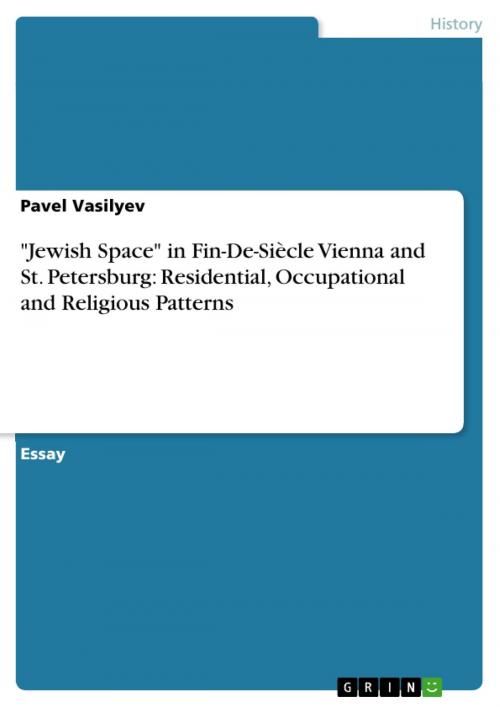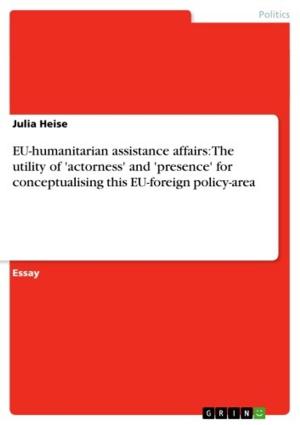'Jewish Space' in Fin-De-Siècle Vienna and St. Petersburg: Residential, Occupational and Religious Patterns
Nonfiction, History, European General| Author: | Pavel Vasilyev | ISBN: | 9783640783618 |
| Publisher: | GRIN Publishing | Publication: | December 22, 2010 |
| Imprint: | GRIN Publishing | Language: | English |
| Author: | Pavel Vasilyev |
| ISBN: | 9783640783618 |
| Publisher: | GRIN Publishing |
| Publication: | December 22, 2010 |
| Imprint: | GRIN Publishing |
| Language: | English |
Essay from the year 2010 in the subject History Europe - Other Countries - Newer History, European Unification, grade: A-, University CEU San Pablo Madrid, language: English, abstract: At first glance, the historical Jews do not seem to have been a group that was determining the architectural, visual and spatial outlook of cities - in Europe or overseas alike. In fact, as Rudolf Klein put it, 'the Jews were seldom in a position - save in ancient and modern Israel - to impose architecture on others'; partially because they 'moved so many times in history that they lacked the preconditions for a continuous architectural evolution'. Moreover, architecture has always been considered a Jewish 'specialty' much less then, say, literature, medicine or business. However, I will show that a closer look at the connections between the Jews and the urban space is an important and promising enterprise that tells us a lot about the Jews, the city - and also about Gentiles. The focus of this paper is on the fin-de-siècle period (late 19th - early 20th centuries) and on the two capital cities of Vienna and St. Petersburg - and for some reasons. Both cities were capitals of the empires (Austria-Hungary and the Russian Empire, respectively), that were powerful enough to be a major military and financial competitors, but still technologically and economically backward. The transition to modernity in both capitals was late and problematic, and the Jewish communities have faced a long and persistent anti-Semitism. In both contexts, however, the Jews were especially successful and over-represented in the most modern professions - and also more visible in the rapidly changing modern urban space. Thus, this paper also compliments to the perspective that analyzes 'Jewish space' in fin-de-siècle capitals - and brings a comparative element into the picture. Accordingly, in this paper I will look at the Jewish experiences in turn-of-the-century Vienna and St. Petersburg to compare the visions, images and representations of the 'Jewish space' in the two imperial capitals that were struggling through modernity. I am particularly interested in residential, occupational and religious aspects of the 'Jewish space' as these were the factors that determined the everyday life cycle of particular Jews. Additionally, I want to trace the potential influence that the Jewish patterns of space organization may have exercised upon Gentile ones around turn of the century.
PhD (Kandidat Nauk), Russian History, St. Petersburg Institute of History of the Russian Academy of Sciences, 2013 MA, Central European History and Jewish Studies, Central European University (Budapest, Hungary), 2010 (with distinction) BA (Specialist Degree), History, St. Petersburg State University, Russia, 2009
Essay from the year 2010 in the subject History Europe - Other Countries - Newer History, European Unification, grade: A-, University CEU San Pablo Madrid, language: English, abstract: At first glance, the historical Jews do not seem to have been a group that was determining the architectural, visual and spatial outlook of cities - in Europe or overseas alike. In fact, as Rudolf Klein put it, 'the Jews were seldom in a position - save in ancient and modern Israel - to impose architecture on others'; partially because they 'moved so many times in history that they lacked the preconditions for a continuous architectural evolution'. Moreover, architecture has always been considered a Jewish 'specialty' much less then, say, literature, medicine or business. However, I will show that a closer look at the connections between the Jews and the urban space is an important and promising enterprise that tells us a lot about the Jews, the city - and also about Gentiles. The focus of this paper is on the fin-de-siècle period (late 19th - early 20th centuries) and on the two capital cities of Vienna and St. Petersburg - and for some reasons. Both cities were capitals of the empires (Austria-Hungary and the Russian Empire, respectively), that were powerful enough to be a major military and financial competitors, but still technologically and economically backward. The transition to modernity in both capitals was late and problematic, and the Jewish communities have faced a long and persistent anti-Semitism. In both contexts, however, the Jews were especially successful and over-represented in the most modern professions - and also more visible in the rapidly changing modern urban space. Thus, this paper also compliments to the perspective that analyzes 'Jewish space' in fin-de-siècle capitals - and brings a comparative element into the picture. Accordingly, in this paper I will look at the Jewish experiences in turn-of-the-century Vienna and St. Petersburg to compare the visions, images and representations of the 'Jewish space' in the two imperial capitals that were struggling through modernity. I am particularly interested in residential, occupational and religious aspects of the 'Jewish space' as these were the factors that determined the everyday life cycle of particular Jews. Additionally, I want to trace the potential influence that the Jewish patterns of space organization may have exercised upon Gentile ones around turn of the century.
PhD (Kandidat Nauk), Russian History, St. Petersburg Institute of History of the Russian Academy of Sciences, 2013 MA, Central European History and Jewish Studies, Central European University (Budapest, Hungary), 2010 (with distinction) BA (Specialist Degree), History, St. Petersburg State University, Russia, 2009















